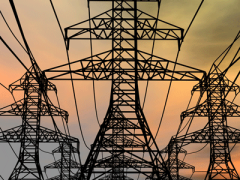Reaching 2030 climate goal becomes extremely unlikely; extra policy with rapid effect is needed
It is extremely unlikely that the Netherlands will reach the legal climate goal of a 55% reduction in greenhouse gas emissions (GHG) by 2030. With current implemented policy (‘proposed and adopted’), we are on track for a reduction of 44%-52% in 2030, compared to 1990 levels. Calculable plans (‘scheduled policy’) do not add much to this: a net 45%-52% reduction. The projected maximum emission reduction is therefore 5 percentage points lower than last year’s projection. The Climate and Energy Outlook of the Netherlands (KEV) of 2024 concludes that only additional policy with rapid effect can bring the climate goal for 2030 back in sight.
Higher projected emissions due to setbacks in implementation and cancelled policy measures
This year the projected emission reduction in 2030 is 1-5 percentage points lower than the 46%-57% calculation of last year. This is partially due to setbacks in implementation, such as delays in offshore wind farms and stagnating production of green hydrogen. Moreover, political choices in the past year contribute to a lower projected emission reduction. This includes the cancellation of Pay as you Go (kilometre pricing) and policy changes by the new Dutch Cabinet (e.g. the wish for renewed manure derogation, raising the maximum driving speed, and abolishing the netting arrangement for solar panels). Without new plans – and rapid implementation – the Netherlands will not reach its goal of 55% reduction. To reach the goal with a probability of 50%, an additional emission reduction of 16 megatons in 2030 is needed; to reach the goal with an extremely high probability (95%), 24 megatons of reduction is required. Scheduled plans that were not calculable in the KEV can, according to the Climate Memorandum (Klimaatnota) by the Cabinet, bridge only a small part of these reductions.
Numerous policy plans have been worked out over the past two years
Over the past two years, numerous plans have been developed further and converted into law (proposals) or legislation. Hence, significant progress has been made at the bottom of the bandwidth (44%-52%). In the KEV 2022, this was only 39%; now, this lies 5 percentage points higher. The emission reduction lies predominantly in mobility (different fiscal legislation and increased admixture of biofuels due to the European guideline RED III), in the built environment (faster uptake of heat pumps), and in industry (CO2-tax and stimulating subsidies for CCS). In the electricity sector, emissions are actually projected to rise, due to a delay in the rollout of offshore wind farms and an increase in electricity demand. According to the KEV 2024 projection for 2030, c. 70% of electricity will be renewable, while the KEV 2022 projected c. 85%.
Time is running out to meet the 2030 climate goal
Policy that takes a long time to implement, will be unable to bridge the gap in the five years left until 2030. It is important to pay attention to the differences in time to action between different policy measures (standardise, subsidise, price), as concluded by the publication about 10 years of National Energy Exploration (NEV) and Climate and Energy Outlook (KEV). Changes to legislation can take multiple years and market parties need to have sufficient time to prepare for a new norm. For example, the green gas blending requirement announced in 2020, if quickly passed by the House of Representatives and the Senate, will only be implemented in 2026. For large investments, five to ten years is the standard. For example, the CO2-capture project Porthos has been in development since 2018, but is only likely to be operational by 2026. Pricing, however, can have act much faster. For example, changing existing taxation rules can already deliver within a year. The implementation of brand new taxation measures, however, does take a longer time. Alongside new policy that can have effects in the short term, it goes without saying that it is imperative to continue working on policy for the long term as well.
Insufficient emission reduction towards 2040 and 2050
Alongside the projection for 2030, the KEV also contains a projection for 2035 and a look towards 2040. The projection indicates that the 55% emission reduction goals set for 2030, will likely only be reached in 2035. This means that the speed of emission reduction under current policy is insufficient for climate neutrality by 2050 or an indicative emission reduction of approximately 90% by 2040 within the EU (as proposed by the European Commission). To meet these goals an emission reduction speed of 7.3 megatons/year would be necessary. The reduction speed between 2018 and 2023 was very high with 9 megatons CO2-eq/year, but, according to the projections, this will drop to a mere 3.8 megatons/year in the years towards 2035.
European emission target ESR well within reach
The Netherlands is well on track to reach the European emission targets under the Effort Sharing Regulation (ESR) for sectors outside of the emissions trading system ETS1 for industry and electricity (based on a 48% emission reduction in 2030 compared to 2005). This cumulative goal provides an emission budget of 830 megaton for 2021-2030 for the sectors of built environment, mobility, and agriculture. In the projections, the Netherlands remains well below this ceiling with 781-819 megatons. This is partially due to a sharp decrease in emissions due to COVID-19, higher energy prices, and rapid growth in wind and solar energy in the last few years. From 2027 onwards, the emissions in the ESR-sectors are projected to be above the emission pathway set out by the ESR.
Goals for renewable energy as well as energy savings require attention
Last year, 17% of energy use came from renewable sources, thus meeting the goal of 16% in 2023 (Energy Agreement of 2013). The European goal for renewable energy for the Netherlands was, last year, sharply raised from 27% in 2030, to 39% in 2030. The now projected 30%-37% is significantly below the new target. The projection is 1-4 percentage points lower than last year due to less offshore wind, fewer solar panels, fewer heat pumps, and less energy savings. The European goals for energy savings for 2030, equally raised last year, also require extra attention.
Retrospective on ten years of energy explorations
In 2014, the first NEV was published as a predecessor of the KEV. A recently published retrospective (24 October 2024), looking back at this past decade, shows significant differences between the sectors. Greenhouse gas emissions in the electricity sector will probably have decreased most in 2030, although they initially increased. In industry, the reduction in 2030 is also relatively high, but the decrease started earlier. In the next few years, mobility is making strides because of the rise of the electric car. On the other hand, agriculture has, over the years, had difficulty reaching its targets. For example, it is extremely unlikely that the methane goal of a reduction of 30% in 2030, compared to 2020, will be reached; the reduction does not exceed 13%-22%. This will be even lower if the Cabinet succeeds in reversing the derogation on the Nitrate directive.
The KEV as a monitoring and accountability tool
Under the Climate Act, the annual Climate and Energy Outlook of the Netherlands is an accountability tool of Dutch climate and energy policy. The KEV also monitors progress and provides insight into the projected effects of proposed and adopted policy measures. The KEV is written by PBL in close collaboration with TNO, CBS, and RIVM, and with contributions by RVO and WUR.




